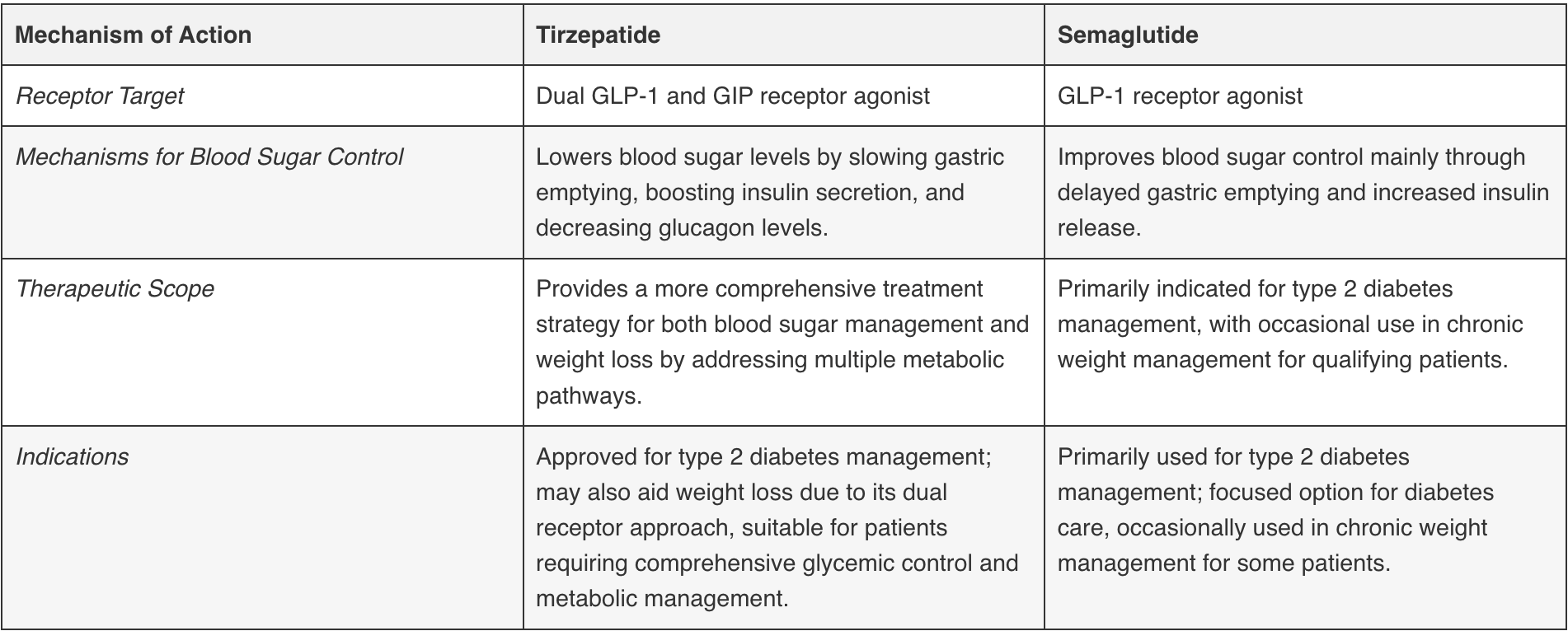Both are innovative medications making waves in the treatment of type 2 diabetes, but understanding their differences is crucial for making informed decisions about your health.
These drugs, while similar in their goals to improve blood sugar control, differ in their mechanisms and potential benefits.
Key Differences Between Tirzepatide and Semaglutide
Tirzepatide and semaglutide both target the GLP-1 receptor but differ in their chemical composition and mechanisms of action, influencing their effectiveness in managing diabetes and weight loss.
Chemical Structure
- Tirzepatide: This drug acts as a dual agonist with a structure allowing it to engage both the GLP-1 and GIP receptors. By targeting two receptors, tirzepatide offers a broader spectrum of metabolic effects.
- Semaglutide: Unlike tirzepatide, semaglutide is a single agonist, interacting solely with the GLP-1 receptor. Its specificity to one receptor means it has a singular approach to interacting with bodily hormones.
Mechanisms of Action Comparison

Side Effects and Safety Profile
Understanding the side effects and safety of tirzepatide and semaglutide helps in making informed health decisions. Both medications have distinct profiles warranting detailed examination.
Tirzepatide Side Effects
Tirzepatide can cause common side effects including nausea, diarrhea, and decreased appetite. Higher doses might increase the likelihood of these symptoms. Some patients experience vomiting and constipation.
Rare, severe side effects can include pancreatitis and hypoglycemia, especially when used with other diabetes medications. Monitoring by healthcare providers helps in managing these potential concerns.
Semaglutide Side Effects
Semaglutide’s side effects are similar, with nausea, vomiting, and diarrhea occurring frequently in initial phases of treatment. Other possible side effects include abdominal pain and fatigue. Severe side effects, though rare, can involve gallbladder issues and pancreatitis.
Consistent communication with your healthcare provider ensures safe use of semaglutide, addressing any arising concerns promptly.
Comparative Safety Analysis
When compared, both tirzepatide and semaglutide share similar gastrointestinal side effects, but the overall safety may vary based on individual response. Tirzepatide’s dual-acting mechanism could introduce different risks compared to semaglutide’s singular focus.
For weight management and glycemic control, evaluating both efficacy and safety profiles facilitates a balanced approach, considering your unique health needs.
Cost and Availability
Understanding the costs associated with tirzepatide and semaglutide is essential for making informed treatment choices. Both drugs may vary in price depending on factors like location.
Tirzepatide Pricing
Tirzepatide typically has a higher cost due to its dual-action mechanism, depending on which provider you choose.
Semaglutide Pricing
Semaglutide generally has a lower price point compared to tirzepatide.
Enhance.MD provides compounded semaglutide at a flat rate of $249, regardless of dosage, ensuring predictable and affordable pricing for all patients.
Frequently Asked Questions
What are tirzepatide and semaglutide used for?
Tirzepatide and semaglutide are medications used to improve blood sugar control in individuals with type 2 diabetes. Tirzepatide targets multiple receptors, whereas semaglutide acts solely on the GLP-1 receptor. Both have shown efficacy in lowering HbA1c levels and supporting weight loss.
How do tirzepatide and semaglutide differ in their mechanisms?
Tirzepatide works by engaging both GLP-1 and GIP receptors, offering a broad metabolic impact. Semaglutide, meanwhile, interacts only with the GLP-1 receptor. This difference leads to tirzepatide having a more comprehensive metabolic approach compared to semaglutide’s focused mechanism.
What are some common side effects of these medications?
Both medications have similar side effects, including nausea, diarrhea, and decreased appetite. They may also lead to more severe issues like pancreatitis. Monitoring individual side effects is important to adjust treatment as necessary.
Are there cost differences between tirzepatide and semaglutide?
Yes, tirzepatide typically has a higher cost due to its dual-action mechanism. Semaglutide generally costs less.
Is one medication more effective than the other?
Effectiveness depends on individual health needs and how each person responds to the medication. Tirzepatide offers a broader spectrum of metabolic effects, possibly providing more comprehensive management, while semaglutide focuses mainly on blood sugar control. Consulting with healthcare providers is essential for personalized treatment decisions.
Conclusion
When choosing between tirzepatide and semaglutide for managing type 2 diabetes it’s essential to weigh their unique benefits and mechanisms. Tirzepatide’s dual-action approach offers broader metabolic effects while semaglutide provides a targeted strategy for blood sugar control.
Consider the safety profiles and potential side effects of each medication and how they align with your health needs. Ultimately discussing these factors with your healthcare provider will ensure you select the most suitable option for your diabetes management journey.










